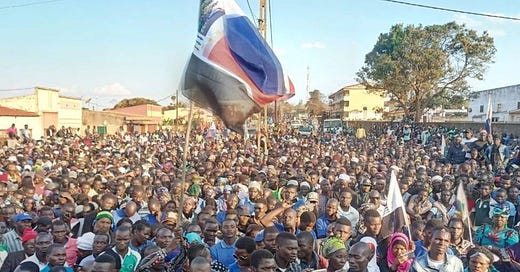See Project Mozambique Part II
FRELIMO (Frente de Libertação de Moçambique) was founded in 1962 as a nationalist movement. At the time, its sole function was to oppose its Portuguese colonizers violently.
During this time, it found sympathy in the communist powers of China and the Soviet Union, which backed it financially and with arms.
Power fell into FRELIMO’s hands in 1975 following a leftist coup in Portugal that saw the country withdraw from the Southern African territory.
Rhodesia’s minority regime collapsed in 1980, and the Apartheid South African government, which was still embroiled in the bush wars against African guerrillas and the Angolan war against communist Cubans, took over RENAMO.
They used the faction to sabotage railway and power lines, roads and bridges, oil depots, and other infrastructure.
RENAMO’s mandate extended to small towns and villages, and by the late 1980s, they were responsible for at least 600,000 deaths and displacements, resulting in 1,700,000 refugees and 200,000 orphans.
The international advocacy group Human Rights Watch’s Africa Watch Report on Conspicuous Destruction, published in July 1992, notes that both sides committed atrocities during which whole communities faced forced relocations while their children were taken from them, given guns, and made to fight.
But “RENAMO,” the paper pointed out, “must take a greater share of the blame.”
In 1989, RENAMO started taking a beating from a cult militia named Naparama.
Naparama was led by a charismatic, traditional healer who claimed he could make his warriors immune to bullets.
Counterintuitively, the group was in a few instances able to rout well-armed RENAMO encampments with nothing but spears.
RENAMO, embarrassed by their losses to this poorly armed upstart, responded in force and on numerous occasions, attacked and mutilated nonmilitary Naparama communities to prove that they were not immortal.
RENAMO as an Apartheid Proxy
Rhodesia’s minority regime collapsed in 1980, and the Apartheid South African government, which was still embroiled in the bush wars against African guerrillas and the Angolan war against communist Cubans, took over RENAMO.
They used the faction for sabotage on railway and power lines, roads and bridges, oil depots, and other infrastructure.
Their raids extended to small towns and villages, and by the late 1980s, they were responsible for at least 600,000 deaths and displacements, resulting in 1,700,000 refugees and 200,000 orphans.
The international advocacy group Human Rights Watch’s Africa Watch Report on Conspicuous Destruction, published in July 1992, notes that both sides committed atrocities and that whole communities faced forced relocations while their children were taken from them, given guns, and made to fight.
But “RENAMO,” the paper pointed out, “must take a greater share of the blame.”
In 1989, RENAMO started taking a beating from a cult militia named Naparama.
Naparama was led by a charismatic, traditional healer who claimed he could make his warriors immune to bullets.
Counterintuitively, the group was in a few instances able to rout better-armed RENAMO encampments with nothing but spears.
RENAMO, embarrassed by their losses to this poorly armed upstart, responded in force and on numerous occasions, mutilated nonmilitary members of Naparama communities to prove that they weren’t so immortal after all.
This civil war continued until 1992, all but destroying Mozambique’s economy.
When neighboring Zimbabwe gained its independence in 1980, its leader, Robert Mugabe, who viewed apartheid South Africa as a threat, sent troops to Mozambique to help fight RENAMO and protect elements like the Beira Corridor, which was a crucial rail artery connecting his country to the Indian Ocean via Mozambique.

Other countries that helped FRELIMO during this period were Tanzania and Malawi. In the late 1980s, after being accused of siding with RENAMO, Malawi allowed Tanzania to use its territory for logistical support in its endeavours against the rebels.
Notably, at the time, RENAMO was receiving support from South Africa and America, which was somewhat of a default because of FRELIMO’s alliance with the U.S.’s arch enemy, communism.
The Ceasefire
On Oct. 15, 1992, RENAMO and FRELIMO signed a ceasefire that has held until today, even though fragile, endangered by isolated instances of violence, and peppered with complaints of election fraud.
During this period, FRELIMO reigned continuously.
Now that you have acquainted yourself with RENAMO, read about FRELIMO in Part IV: First Party Through the Gate.







